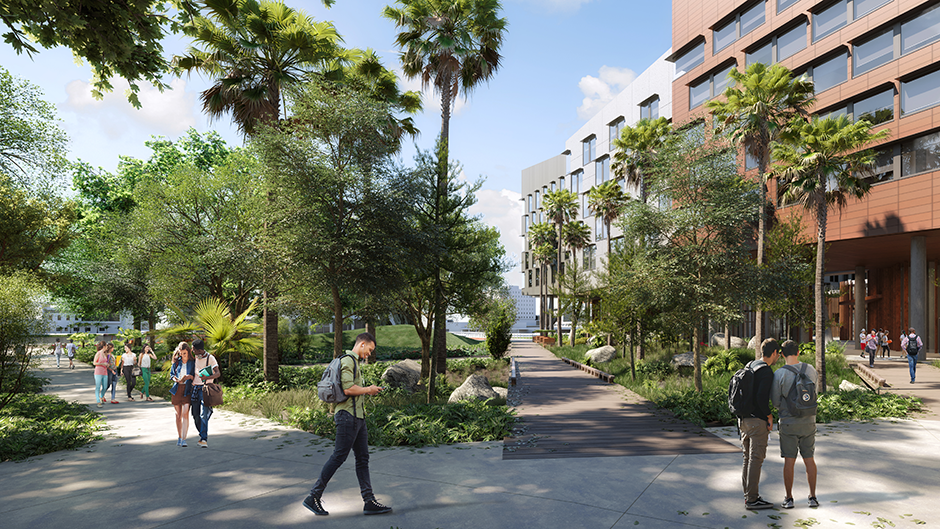The University of Miami is going for the gold – LEED Gold – in the construction and operation of the Student Housing Village currently under construction on the Coral Gables campus. Like all new construction projects at the University of Miami, the 12-acre village employs the latest innovations in construction and design to achieve LEED certification and contribute to the sustainable initiatives of the campus and local communities.
LEED, which stands for Leadership in Energy and Environmental Design, is a rating system devised by the United States Green Building Council (USGBC) to evaluate the environmental performance of a building and encourage designers and builders to integrate sustainable elements into a project. With four different certification levels, LEED uses a scoring matrix to evaluate all projects on a variety of measures including the materials used, energy systems installed, the operation of the building and innovative design features.
“From the earliest stages of this project, we explored innovations in sustainable building and design techniques,” says Juan Endara, senior project manager. “Not only did UM make a commitment for all new construction to achieve at least LEED silver certification, but we also know how important the environment is to our students and our campus community at large.”
The Student Housing Village’s innovative design features such as rooftop green spaces, a rain garden and efficient heating and cooling systems all contribute to its LEED certification. UM also scored points by re-locating, rather than destroying, plants and trees elsewhere in the community or incorporating them into the new design of the site.
Specifically, the village’s green roofs reduce and slow down water runoff, provide food for pollinator species of animals, naturally insulate the building, and absorb carbon dioxide to clean the air and help regulate the climate. Insulated walls and enhanced window glazing help to regulate the interior temperature without relying on cooling or heating systems. Innovative heating and cooling systems are designed to condition and filter the air as well as re-purpose it for other uses throughout the facility. A rain garden has also been incorporated into the design of the village to provide several environmental benefits and aid in storm water management.
“The University’s many efforts to reduce its carbon footprint have put us on the right track,” says Teddy Lhoutellier, the University’s sustainability manager. “We know that incoming students take into account a university’s sustainability initiatives when picking a school attend. UM should be proud to be among the best contenders, and the Student Housing Village will be a living statement of UM’s commitment to sustainability.”
In addition to formally achieving LEED Gold status, the Student Housing Village also aims to incorporate elements of the International WELL Building Institute’s standards for human health and well-being. Components of this standard include air quality, lighting conditions and the overall comfort of a space.
The seamless flow from indoor to outdoor spaces, the use of natural light and a comforting color palate, and indigenous flora lining outdoor covered walkways all contribute to the high standard of living that resident students can expect from their residential experience in the village.
“Feeling a sense of place and comfort is one of the most important elements of fostering a lively and active community,” says Jim Smart, executive director of the Department of Housing & Residential Life. “And perhaps more importantly, spaces that put students’ well-being above all else create an environment where they can be successful in their academic and co-curricular pursuits. If students feel well, they can think and do well.”
Read more about the Student Housing Village or the University’s Sustainability Action Plan 2019 for more information about UM’s commitment to preserving the environment.

